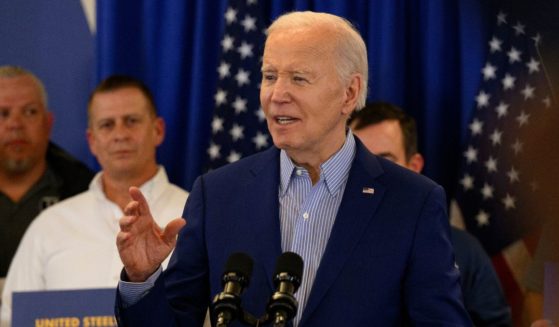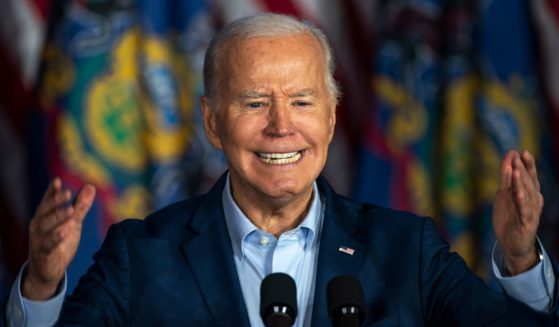Photos Show What US Admiral Meant When He Warned of China's 'Breathtaking' Nuclear Expansion
In April, U.S. Navy Adm. Charles Richard, the commander of U.S. Strategic Command, warned a congressional panel that China’s nuclear program was in the midst of a “breathtaking expansion,” including the development of intercontinental ballistic missiles, mobile missile launchers and nuclear-capable submarines.
Now, satellite imagery has confirmed that Richard was by no means exaggerating.
Researchers from the James Martin Center for Nonproliferation Studies in Monterey, California, obtained the images which were initially captured by commercial satellites.
The images depict the construction of over 100 new silos for ICBMs in the desert outside the city of Yumen, which is in northwestern China, The Washington Post reported.
Should these 119 near-identical construction sites be completed, it would mark a significant expansion in the country’s relatively meager stock of nuclear weapons. The Post noted that the number of silos doesn’t necessarily indicate the number of weapons intended to be stored within them, as China has been known to use decoy silos in the past in a similar fashion to a strategy used by the U.S. during the Cold War to mislead Soviet intelligence forces.
“The reported silo construction project could provide China with yet another means of concealing its most powerful weapons. The construction sites spotted on satellite photos are arrayed in two huge swaths, covering parts of a desert basin stretching to the west and southwest of Yumen, a city of 170,000 people along China’s ancient Silk Road,” The Post explained.
“Each site is separated from its neighbors by about two miles, and many of the sites are concealed by a large, dome-like covering, following a practice observed at known construction sites for missile silos in other parts of China. At sites where the dome is not in place, construction crews can be seen excavating a characteristic circular-shaped pit in the desert floor. Another construction site appears to be a partially built control center.”
Jeffrey Lewis, who was part of the team that reviewed the satellite images, explained in a summary of his analysis on the findings as provided to The Post that, when added to similar construction projects, these silos would bring the total count to 145 across the Chinese mainland.
Breaking news: China’s building 100+ nuclear missile silos in its desert. In 2020 it was 100+ potential Uighur detention camps, now this.
Great work @ArmsControlWonk @MIIS!@Planet will continue to help journalists find & shed light on key global events.https://t.co/aKYJeIQvpV pic.twitter.com/SVYbj0KsaN
— Will Marshall (@Will4Planet) June 30, 2021
“We believe China is expanding its nuclear forces in part to maintain a deterrent that can survive a U.S. first strike in sufficient numbers to defeat U.S. missile defenses,” he explained.
This intelligence underscores the urgency with which China is bolstering its defenses in likely anticipation of any attempt at foreign intervention in its aggressive expansion of power both at home and abroad.
Lewis, who described the sheer scale of the construction projects as “incredible,” believes the silos are likely intended for a Chinese ICBM known as the DF-41, which is capable of carrying multiple warheads and can strike targets as far off as 9,300 miles.
Yes — that means they could, potentially, have the capacity to reach the U.S. mainland.
Although the U.S. Department of Defense declined to comment on the satellite images or discuss any of its own intelligence on China’s nuclear capabilities, a spokesperson pointed to previous warnings that any such concern is likely justified.
“Defense Department leaders have testified and publicly spoken about China’s growing nuclear capabilities, which we expect to double or more over the next decade,” spox John Supple said.
Lewis believes that China, which boasts a significantly smaller nuclear arsenal than those in the U.S. and Russia, has engaged a “limited deterrence” doctrine that simply prioritizes its ability to retaliate if attacked.
Yet while he believes that the satellite images could be indicative of a “shell game” on the part of China, i.e. that they’re simply designed to give the appearance that they’re more nuclear-capable than they really are, the sheer multitude of so many potential launch sites could serve as a warning to U.S. officials to modernize our own arsenal.
China is building more than 100 new missile silos in the deserts of Gansu and Yumen provinces to expand its nuclear arsenal and survive a possible first nuclear strike by the US and hit back, establishing a deterrence. By assured mutual destruction. Washington post reports. pic.twitter.com/NFpaimEjPg
— Khayyam Salik (@SLKKhayyam) July 1, 2021
While Secretary of State Antony Blinken said in February that the Biden administration plans to “pursue arms control to reduce the dangers from China’s modern and growing nuclear arsenal,” he offered no specifics on what this would look like, merely vowing to pursue “effective arms control that enhances stability, transparency and predictability while reducing the risks of costly, dangerous arms races.”
It appears that we’re in an arms race with China whether we like it or not, however, and that’s exactly where the nation wants us to be.
In 2019, China unveiled new nuclear warheads amid massive pomp and circumstance reminiscent of Soviet and Mao-era military parades as the 70th anniversary of the establishment of the People’s Republic of China was being celebrated. This came as a trade war with the United States loomed thanks to former President Donald Trump’s tough stance on the aspiring global superpower.
That was when the DF-41 made its public debut amid the tightly synchronized goose-stepping and Cold War-style theatrics of the celebratory parade.
Now that President Joe Biden is in office, Beijing has made clear it’s hardly afraid of Trump’s successor — a fact made embarrassingly plain in the first diplomatic talks between his administration and China when the nation’s diplomatic team publicly humiliated Blinken — on U.S. soil, no less.
The Biden administration has publicly condemned China’s human rights abuses among the Uyghur population in the Xinjiang province and its authoritarian crackdown in the previously liberal and autonomous Hong Kong, but has stopped short of taking any action against the antagonistic communist nation.
During his remarks on the centennial anniversary of the founding of the Chinese Communist Party this week, President Xi Jinping vowed “broken heads and bloodshed” to any foreign adversaries which provoke or enrage China, a message which is entirely consistent with the notorious “wolf warrior” diplomacy exercised by his regime.
China may be doing its best to fluff up its feathers and appear more powerful than it is on the world stage — but it’s determined to increase its power by any means necessary, and it is this fierce determination and fearless provocation of foreign powers that we have to be concerned about.
As long as Biden continues to take a weak and soft stance on China and President Xi, a man he once described as a “friend,” China will take every single advantage such leniency affords it.
Truth and Accuracy
We are committed to truth and accuracy in all of our journalism. Read our editorial standards.












